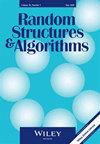拉姆齐超图中派系与恒星的关系
IF 0.8
3区 数学
Q4 COMPUTER SCIENCE, SOFTWARE ENGINEERING
引用次数: 2
摘要
设Km(3)$$ {K}_m^{(3)} $$ 表示m上的完全3‐均匀超图$$ m $$ 顶点和Sn(3)$$ {S}_n^{(3)} $$ n+1上的3‐均匀超图$$ n+1 $$ 由n2个顶点组成$$ \left(\genfrac{}{}{0ex}{}{n}{2}\right) $$ 关联到给定顶点的边。然而许多超图Ramsey数要么以多项式增长,要么以指数增长,我们证明了非对角线Ramsey数r(K4(3),Sn(3))$$ r\left({K}_4^{(3)},{S}_n^{(3)}\right) $$ 表现出不寻常的中间生长速率,即2clog2n≤r(K4(3),Sn(3))≤2c 'n2/3logn;$$ {2}^{c\log^2n}\le r\left({K}_4^{(3)},{S}_n^{(3)}\right)\le {2}^{c^{\prime }{n}^{2/3}\log n}, $$对于某个正常数c$$ c $$ c '$$ {c}^{\prime } $$ . 这些界限的证明带来了网格图上一个新的Ramsey问题,这可能是一个独立的兴趣:最小N是什么$$ N $$ 使得笛卡尔积的任意2边着色KN□KN$$ {K}_N\square {K}_N $$ 包含红色矩形或蓝色Kn$$ {K}_n $$ ?本文章由计算机程序翻译,如有差异,请以英文原文为准。
Hypergraph Ramsey numbers of cliques versus stars
Let Km(3)$$ {K}_m^{(3)} $$ denote the complete 3‐uniform hypergraph on m$$ m $$ vertices and Sn(3)$$ {S}_n^{(3)} $$ the 3‐uniform hypergraph on n+1$$ n+1 $$ vertices consisting of all n2$$ \left(\genfrac{}{}{0ex}{}{n}{2}\right) $$ edges incident to a given vertex. Whereas many hypergraph Ramsey numbers grow either at most polynomially or at least exponentially, we show that the off‐diagonal Ramsey number r(K4(3),Sn(3))$$ r\left({K}_4^{(3)},{S}_n^{(3)}\right) $$ exhibits an unusual intermediate growth rate, namely, 2clog2n≤r(K4(3),Sn(3))≤2c′n2/3logn,$$ {2}^{c\log^2n}\le r\left({K}_4^{(3)},{S}_n^{(3)}\right)\le {2}^{c^{\prime }{n}^{2/3}\log n}, $$for some positive constants c$$ c $$ and c′$$ {c}^{\prime } $$ . The proof of these bounds brings in a novel Ramsey problem on grid graphs which may be of independent interest: what is the minimum N$$ N $$ such that any 2‐edge‐coloring of the Cartesian product KN□KN$$ {K}_N\square {K}_N $$ contains either a red rectangle or a blue Kn$$ {K}_n $$ ?
求助全文
通过发布文献求助,成功后即可免费获取论文全文。
去求助
来源期刊

Random Structures & Algorithms
数学-计算机:软件工程
CiteScore
2.50
自引率
10.00%
发文量
56
审稿时长
>12 weeks
期刊介绍:
It is the aim of this journal to meet two main objectives: to cover the latest research on discrete random structures, and to present applications of such research to problems in combinatorics and computer science. The goal is to provide a natural home for a significant body of current research, and a useful forum for ideas on future studies in randomness.
Results concerning random graphs, hypergraphs, matroids, trees, mappings, permutations, matrices, sets and orders, as well as stochastic graph processes and networks are presented with particular emphasis on the use of probabilistic methods in combinatorics as developed by Paul Erdõs. The journal focuses on probabilistic algorithms, average case analysis of deterministic algorithms, and applications of probabilistic methods to cryptography, data structures, searching and sorting. The journal also devotes space to such areas of probability theory as percolation, random walks and combinatorial aspects of probability.
 求助内容:
求助内容: 应助结果提醒方式:
应助结果提醒方式:


